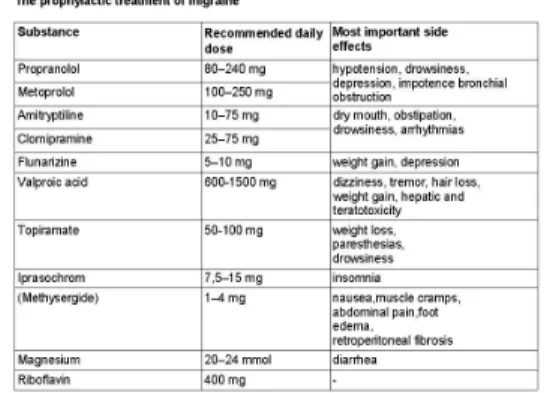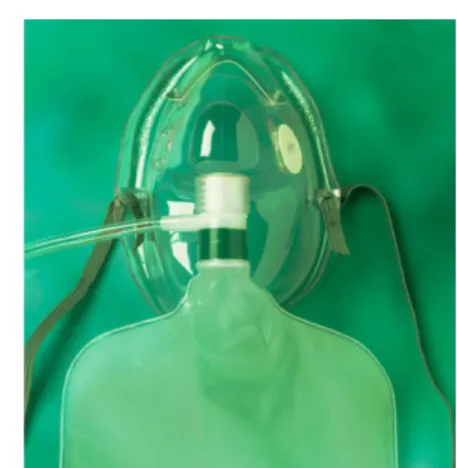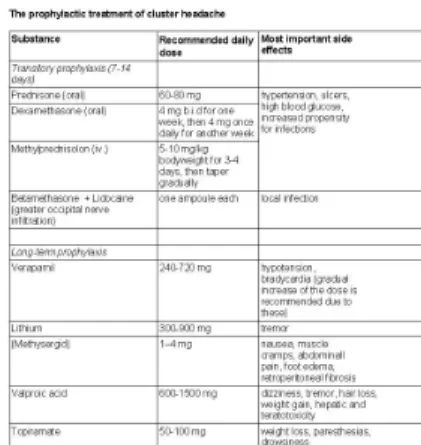III./2.5.: Treatment
The treatment of headaches has two major objectives. Acute or attack therapy is indicated for every stronger headache (i.e. a headache causing relevant discomfort for the patient). Drug classes used for acute therapy include simple and combined analgesics, ergot derivates (which are used with a much narrower indication than previously), and the serotonin 1B/1D agonist triptans. Opiates are not indicated for the acute treatment of primary headaches!
The other objective of headache treatment is the reduction of attack frequency (preventive or prophylactic therapy). Prophylactic therapy is indicated only if the patient has at least one attack per week that is severe enough to necessitate acute therapy. This treatment usually requires the daily use of the prophylactic drug for a period of some months. It is important to recognize that some non-drug interventions (changes in lifestyle, certain psychotherapies) can also reduce headache frequency – on the other hand, a number of ‘alternative’ methods claimed to be effective in the prevention of headaches lack scientific evidence.
III./2.5.1. Treatment of migraine
Acute treatment
A migraine attack should never be left untreated. An effective treatment requires that the medication be administered in an adequate dose and in the early phase of the attack. The type of medication depends on the severity of the attack, on the presence of concurrent conditions, and the outcome of previous treatments. The use of oral formulations is
hampered by nausea and vomiting, which are frequent accompanying symptoms. The pharmacological types and dosing of acute medications, based on the recommendations of the Hungarian Headache Society, are found in Fig. 20.
Fig. 20: Acute treatment of migraine
Analgesics may be effective in mild to moderate migraine attacks; their efficacy may be augmented if combined with caffeine and/or
antiemetics. The role of ergot derivates (ergotamine,
dihydroergotamine) became less important in the last decade: due to their vasoconstrictive side effects, they cannot be administered to patients with angina, coronary disease, peripheral artery disease and uncontrolled hypertension. They are also contraindicated during pregnancy and breast-feeding, and in septicaemia. The maximum dose
of ergotamine is 4 mg daily and 16 mg monthly. Kefalgin, an oral ergot derivative still on the market in Hungary, is seldom effective due to its low ergotamine content and oral formulation. Dihydroergotamine is not marketed in Hungary; its iv. formulation is used in the treatment of long-lasting migraine that is refractory to other acute medications (so-called ‘status migrainosus’).
The serotonin 1B/1D receptor agonist triptans are currently the most effective drugs for the acute treatment of migraine. There are several triptan preparations; sumatriptan, eletriptan and zolmitriptan are marketed in Hungary. Oral triptans effectively reduce migraine pain, subcutaneous sumatriptan (in an autoinjectable form) is rapidly effective even in severe attacks accompanied by vomiting. Triptans are
contraindicated during pregnancy, in the case of ischemic heart disease, angina, myocardial infarction, uncontrolled hypertension, and in basilar or hemiplegic migraine. Treatment with MAO-inhibitors, serotonin reuptake inhibitors and lithium also precludes the use of triptans. The use of triptans is limited by their substantial price.
Prophylactic treatment
In migraine, prophylactic treatment is indicated if the frequency of attacks is high (>4 attacks/month), or the attacks are long-lasting and refractory to acute therapy. The most commonly used medications are summarized in Fig. 21. Prophylactic treatment is usually given for a period of 6 to 12 months. Treatment is considered effective if the number of attacks per month or number of headache days per month is decreased by at least 50%. If the patient’s headaches respond to the therapy (i.e. the attacks become less frequent, less severe and are better treated by acute medications), a gradual withdrawal and then
discontinuation of prophylaxis is recommended. If there is a positive, but not very pronounced effect or there is concomitant depression or fibromyalgia, we opt for a longer treatment period. If no response is observed, the prophylactic agent is discontinued after two months and a different medication is started. If a patient is refractory for several prophylactic agents, his/her re-evaluation is necessary to rule out concomitant disease (medication overuse, psychiatric illness, other conditions that could influence the headaches).
Fig. 21: Prophylactic treatment of migraine
III./2.5.2.: Treatment of cluster headache
A cluster headache attack is extremely painful, therefore the possibilities of non-pharmacological treatment are limited and the recommendation of these treatments is not justified. The only non-pharmacological approach that could have a benefit for the patient is avoiding provoking
factors (such as alcohol, nitroglycerin, histamine, hot baths/environment).
Acute treatment
Due to the extreme severity of the attacks a rapid and effective pain control is essential. Oral preparations are seldom effective; using soluble formulations may be an exception, but the efficacy of this group has not been verified by large-scale studies to date. Beside rapid
administration and great efficacy, simple and safe administration and mild and transient side effects are further requirements.
International literature recommends the inhalation of 100% oxygen or the administration of triptans for the acute treatment of the CH attacks.
100% oxygen should be given through a non-rebreather mask: its inhalation for 7 to 10 minutes would terminate 70% of the attacks. In Hungary, oxygen can be prescribed by board-certified neurologists for the treatment of cluster headache.
Fig. 22: Non-rebreather mask for oxygen treatment.
Due to the quicker onset of action, parenteral formulations of triptans are advisable for the acute treatment of CH; in Hungary, not all patients can afford these due to their high price. Their administration requires some caution due to their vasoconstrictive side effects (for
contraindications refer to the paragraph about the acute treatment of migraine).
Fig. 23: Acute treatment of cluster headache
Prophylactic treatment
As the possibilities of acute therapy are quite limited, the prophylactic treatment of cluster headache is a very important issue. Most of these medicines are given in a gradually increasing dose, therefore the effect of prophylactic treatments would usually appear 1 to 2 weeks after starting them. In order to achieve a significantly smaller headache
frequency, the concurrent use of transitory prophylactics is warranted.
The aim of transitory prophylaxis is to significantly decrease attack frequency until the dose of the long-term prophylactic agent reaches therapeutic range. Transitory prophylaxis is mostly achieved by administering corticosteroids.
Among the drugs used for long-term prophylaxis, the efficacy of verapamil has been substantiated by the highest number of studies, and it is the drug of choice for the prophylaxis of episodic CH. Its
mechanism of action in CH is not known. Given the fact that only high doses are effective for the prevention of CH (i.e. doses that are 2 to 3 times higher than the usual cardiologic dose), verapamil should be administered in a gradually increasing dose, monitoring heart rate and blood pressure. Beside its cardiovascular side effects ,verapamil can rarely cause GI ulcers. Other drugs commonly used for the prophylaxis of episodic CH include valproate, topiramate, and methysergide.
The drug of choice for the prophylaxis of chronic CH is lithium. The dosing of lithium requires special care, as there can be great individual differences in the oral doses that would provide sufficient plasma levels, and the toxic dose is not much higher than the therapeutic one. Lithium is therefore recommended only if patient compliance is adequate and plasma lithium levels should be strictly monitored.
Fig. 24: Transient and long-term prophylactic therapy of cluster headache
III./2.5.3.: Treatment of tension type headache
Episodic tension type headache is effectively treated by simple analgesics in most of the cases. The treatment of the chronic form is often difficult. For prophylaxis, tricyclic antidepressants (clomipramine or amitriptyline 25 to 50 mg monodose daily) are more effective than the widely used SSRIs. Other prophylactic possibilities include valproic acid (150 to 300 mg tid.) and beta-blockers (propranolol 40 mg tid.).
Relaxation, biofeedback, autogenic training, neck exercises (stretching), massage and physiotherapy are reasonable non-pharmacological
options.


